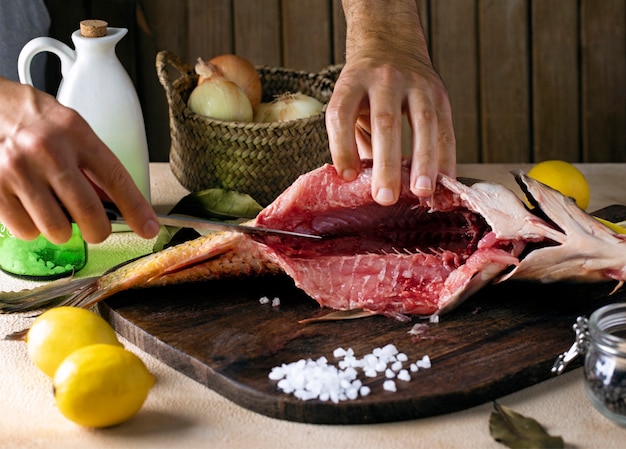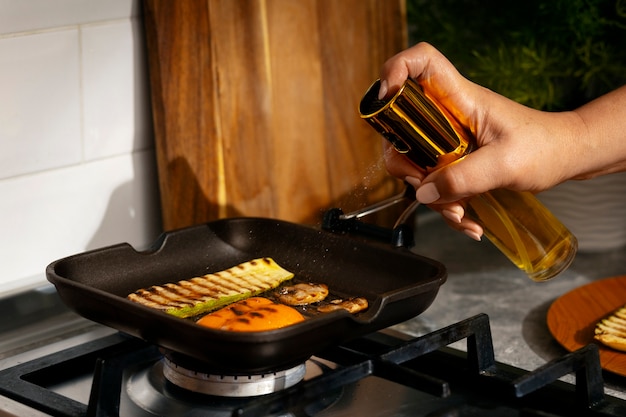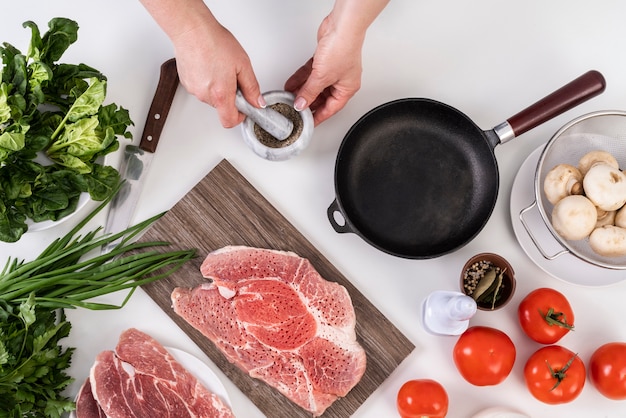Let's talk steak. You know, that glorious piece of protein that can transform a simple weeknight dinner into a celebratory feast. But mastering steak on the stovetop can feel like a daunting task. So many variables, so many opinions, so much pressure to get it right!
Fear not, my fellow culinary adventurers, because I'm here to guide you through every step, from choosing the perfect cut to achieving that coveted, mouthwatering sear. I'm not just sharing random tips here; this is the culmination of years of steak-related adventures, countless experiments (some successful, some...well, let's just say I learned a thing or two about what not to do), and a healthy dose of research. So buckle up, grab your apron, and get ready to elevate your steak game to new heights.
(Part 1) The steak selection: Finding Your Perfect Match

Think of choosing a steak like finding a partner: it's all about finding the right match for your culinary desires. There are so many cuts out there, each with its own unique personality, flavor profile, and texture. Don't be intimidated by the variety; I'm here to help you navigate this fascinating world of beefy delights.
The Cut That Cuts Above the Rest
Here are some of my personal favorites for stovetop cooking, each offering a unique experience for your palate:
- Ribeye: This is the king of the grill, and for good reason. Its marbling – those gorgeous streaks of fat – adds incredible juiciness and flavor. The ribeye delivers a beautiful balance of tenderness and chewiness, with a melt-in-your-mouth quality that's simply irresistible. Be prepared, though: this beauty often comes with a slightly higher price tag.
- new york strip: A classic for a reason, the New York strip offers a leaner profile than its ribeye cousin while still packing a punch of flavor. It boasts a delightful combination of tenderness and firmness, making it incredibly versatile for various cooking methods. And let's not forget the beautiful, even sear it develops.
- Sirloin: This is a more budget-friendly option, but don't mistake affordability for a lack of quality. While it may not be as rich as ribeye or New York strip, the sirloin offers a satisfyingly hearty flavor and texture that's perfect for a quick pan-sear or grilling.
- Tenderloin: Also known as filet mignon, this is the epitome of tenderness. If you're after a melt-in-your-mouth experience, this is your cut. However, its leanness requires careful cooking to avoid dryness, so pay close attention to the timing and temperature.
- flank steak: This is a tougher cut, but don't let that deter you. It's bursting with flavor and best cooked quickly to maintain its juicy tenderness. This makes it perfect for thinly slicing and serving in dishes like fajitas or stir-fries.
Thickness Matters: A Tale of Two Steaks
You might think that any steak will do, but the thickness of your chosen cut plays a crucial role in achieving that perfect cook. For stovetop cooking, aim for a steak that's at least 1 inch thick. This allows for a beautiful sear on the outside while keeping the inside beautifully juicy.
Thinner steaks can absolutely be cooked on the stove, but they require more careful attention to timing and temperature to prevent them from becoming overcooked. For the best results, though, embrace those thicker cuts!
(Part 2) Prepping for Perfection: Setting the Stage for a Stellar Steak

We've chosen our star of the show, now it's time to prep it for its grand entrance on the stovetop. This isn't just about a quick rinse and a sprinkle of salt; proper prep is essential for achieving that incredible sear and ensuring your steak cooks evenly.
The Room Temperature Rule: A Steak's Secret Weapon
Firstly, take your steak out of the fridge and let it sit at room temperature for about 30 minutes. This might seem like an odd rule, but trust me, it's a game-changer. It allows the steak to warm up evenly, ensuring that the internal temperature is more consistent. This leads to a more even cook, preventing the outside from becoming overcooked before the inside reaches the desired doneness.
Don't worry, letting the steak sit at room temperature won't make it go bad. As long as it's not in direct sunlight, it's perfectly safe for a brief period.
Seasoning Your Steak: A Symphony of Flavors
Now, let's talk seasoning. This is where the real artistry begins! While you can certainly experiment with a variety of spices, I'm a firm believer in keeping things simple. Salt and pepper are the essential partners in crime when it comes to a truly delicious steak. And don't hold back – a generous amount of each is crucial for enhancing the steak's natural flavors.
But don't stop there! Feel free to experiment with other spices like garlic powder, onion powder, or paprika, but remember: less is more. You want to enhance the steak's natural flavors, not overwhelm them.
The Pat Down: A Crucial Step for a Crisp Crust
Finally, pat your steak dry with paper towels. This might seem like a minor detail, but it's crucial for achieving that coveted, crispy crust. Excess moisture will prevent the steak from searing properly, resulting in a soggy and disappointing finish.
(Part 3) The Stovetop Sizzle: Where the Magic Happens

Alright, the stage is set, the steak is prepped, and the anticipation is building. It's time to unleash the stovetop magic and transform your steak from raw to a culinary masterpiece.
Choosing the Right Pan: Your Steak's Culinary Stage
Start by choosing your pan wisely. Cast iron is a classic choice, known for its exceptional heat retention and ability to deliver an incredibly even sear. But don't worry if you don't have a cast iron pan; any heavy-bottomed pan with good heat distribution will do the trick.
The key is to make sure your pan is hot. Really hot! Don't be afraid to crank up the heat to medium-high or high, depending on your stove's power.
The Sear: A Culinary Masterpiece in the Making
Now, let's create that masterpiece of a sear – the foundation of a truly exceptional steak. Place your steak in the hot pan and let it cook undisturbed for about 2-3 minutes per side. Resist the urge to move it around! Patience is key here, allowing the steak to develop a beautiful, caramelized crust before you even think about flipping it.
The Flip: A Moment of Truth
After those crucial 2-3 minutes, it's time for the flip. Flip it once, and only once. This ensures a consistent sear on both sides and prevents you from disrupting the crust you've worked so hard to create.
cooking time: Navigating the Levels of Doneness
Here's where the art of cooking steak becomes a little more technical. The cooking time depends on your preferred level of doneness. Here's a quick guide to help you achieve your culinary goals:
| Doneness | Internal Temperature (°F) | Cooking Time (per side) |
|---|---|---|
| Rare | 125-130°F | 2-3 minutes |
| Medium Rare | 130-135°F | 3-4 minutes |
| Medium | 135-140°F | 4-5 minutes |
| Medium Well | 140-145°F | 5-6 minutes |
| Well Done | 145-150°F | 6-7 minutes |
Remember, these are just guidelines. The most accurate way to determine doneness is by using a meat thermometer. Insert it into the thickest part of the steak, avoiding bone, to get a precise reading.
(Part 4) The Rest: The Unsung Hero of steak perfection
So your steak is sizzling, perfectly seared, and nearing its desired doneness. Don't rush to cut it just yet! The next step is a crucial one: the rest.
The Power of Rest: Restoring Juiciness and Flavor
Resting is the unsung hero of steak cooking. It's the moment where you allow the steak's internal temperature to even out and the juices to redistribute throughout the meat. This creates a more tender and flavorful steak.
The Resting Ritual: A Moment of Patience
Simply transfer the steak to a cutting board and cover it loosely with foil. Let it rest for 5-10 minutes. This allows the juices to redistribute, making the steak more juicy and flavorful.
The Slice: The Grand Finale of Your culinary journey
After resting, it's time for the final flourish: slicing. Slice the steak against the grain, meaning slicing perpendicular to the muscle fibers. This makes it easier to chew and helps to release even more flavor.
(Part 5) The Finishing Touches: Elevating Your Steak to New Heights
Your steak is now cooked to perfection, rested, and ready to be enjoyed. But let's not stop there! Adding a few finishing touches can take your steak from good to truly exceptional.
Butter Basting: The Secret to Richer Flavor
One of my favorite ways to finish a steak is by basting it with butter. Simply melt a tablespoon or two of butter in a hot pan and pour it over the steak. The butter adds an incredible richness and flavor, creating a delightful glaze that coats the steak.
Herbs and Garlic: A Burst of Fresh Flavor
For an extra layer of flavor and aroma, consider adding some fresh herbs like rosemary, thyme, or oregano to the melted butter. Chopped garlic is another excellent choice, adding a savory punch.
Lemon Squeeze: The Perfect Balance of Acidity
To balance the richness of the steak and butter, add a squeeze of fresh lemon juice. It cuts through the richness, providing a bright and refreshing counterpoint that elevates the overall flavor profile.
(Part 6) Beyond the Steak: Sides to Complement Your Masterpiece
No steak experience is complete without the perfect side dish. Here are a few ideas to complement your perfectly cooked protein:
- Roasted vegetables: Asparagus, broccoli, Brussels sprouts, and carrots all roast beautifully, adding a touch of sweetness and vibrant color to your plate.
- mashed potatoes: Creamy, comforting, and perfect for soaking up all those delicious steak juices. You can't go wrong with a classic.
- Mac and cheese: Another classic comfort food pairing that's always a crowd-pleaser.
- Salad: For a lighter option, a fresh salad adds a touch of crunch and brightness to your meal.
(Part 7) The Sauces: A Symphony of Flavor to Elevate Your Steak
Want to take your steak to the next level? Consider adding a delicious sauce that complements the flavor and texture of your chosen cut. Here are some classic options to inspire your culinary creativity:
Red Wine Sauce: A Rich and Savory Delight
This is a rich and flavorful sauce that pairs beautifully with ribeye, New York strip, and sirloin steaks. To create this classic, deglaze the pan where you cooked your steak with red wine, allowing the wine to pick up all those delicious browned bits. Then, simply add a knob of butter, a pinch of herbs, and a touch of garlic.
Peppercorn Sauce: A Spicy and Aromatic Twist
For a steak with a spicy kick, consider a peppercorn sauce. Crush some peppercorns and simmer them in a cream sauce, adding a touch of richness and heat.
Béarnaise Sauce: A Classic French Elegance
For a touch of French elegance, Béarnaise sauce is a true classic. This rich and creamy sauce is made with egg yolks, butter, and tarragon, creating a symphony of flavor that will elevate any steak.
(Part 8) FAQs: Answering Your Steak-Related Questions
1. What's the best way to tell if a steak is cooked to my liking?
The most accurate way to determine doneness is by using a meat thermometer. Insert it into the thickest part of the steak, avoiding bone, for a precise reading. The table above provides a guide to internal temperatures for different levels of doneness.
2. Can I use a marinade?
Absolutely! Marinades can add extra flavor and tenderness to your steak. Just be sure to use a marinade that's acidic, like lemon juice, lime juice, or vinegar, to help break down the tough proteins in the meat.
3. How long should I let the steak rest?
Resting the steak for 5-10 minutes after cooking is crucial for allowing the juices to redistribute, resulting in a more tender and flavorful piece of meat.
4. Can I cook a steak on a skillet instead of a cast iron pan?
Yes, you can! Any heavy-bottomed pan with good heat distribution will work well. Just make sure the pan is hot before adding the steak.
5. What are some tips for achieving a perfect sear?
Use a hot pan: Really hot!
Pat the steak dry with paper towels to prevent excess moisture.
Don't move the steak around too much: Let it develop a crust on each side before flipping.
Conclusion: A Culinary Journey Worth Embracing
There you have it, folks, a comprehensive guide to cooking perfect steak on the stove. Now go forth and conquer your kitchen! Remember, practice makes perfect, so don't be afraid to experiment with different cuts, seasonings, and sauces.
The beauty of cooking is that it's a lifelong journey, a constant exploration of flavors and techniques. And the journey to mastering the art of cooking steak is one that's truly worth taking. Now, let's get grilling!
Everyone is watching

How to Cook Frozen Lobster Tails Perfectly: A Step-by-Step Guide
RecipesLobster. Just the word conjures up images of lavish meals, special occasions, and a taste of luxury. But let's...

Pork Fillet Cooking Time: How Long to Cook It Perfectly
RecipesPork fillet, or tenderloin as it's sometimes called, is a real favourite in our house. It's so versatile, and...

Pigs in a Blanket Cooking Time: How Long to Bake for Perfect Results
RecipesAh, pigs in a blanket. Just the name conjures up images of those delightful little parcels of crispy pastry en...

The Ultimate Guide to Cooking Delicious Frankfurters
RecipesLet's face it, we all love a good frankfurter. It's a classic, simple, and always satisfying. But let's be rea...

Wolf Meat Recipes: A Guide to Cooking Wild Game
RecipesLet's be honest, you don't see wolf meat at your local butcher shop every day. It's a bit of a wild card, but ...
